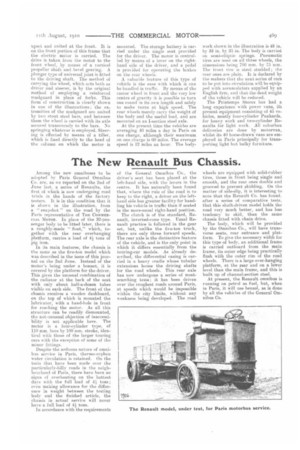The New Renault Bus Chassis.
Page 7

If you've noticed an error in this article please click here to report it so we can fix it.
Among the new omnibuses to be adopted by Paris General Omnibus Co. are, as we reported on the 2nd of June last, a series of Renaults, the first of which is now undergoing road trials in the hands of the factory testers. It is in this condition that it is shown in the illustration, from a " snapshot " on the road by the Paris representative of THE COMMERCIAL= MOTOR. In place of the 32-passenger body to be fitted later, there is a roughly-made " float," which, together with the rear overhanging platform, carries a load of 4i tons of pig iron.
In its main features, the chassis is the same as the five-ton model which was described in the issue of this journal on the 2nd June. Instead of the motor's being under a bonnet, it is covered by the platform for the driver. This gives the unusual combination of the radiator at the back of the scat with only about half-a-dozen tubes visible on each side. The front of the chassis receives a wooden dashboard, on the top of which is mounted the lubricator, with a band-hole in front for reaching the motor. As all this structure can be readily dismounted, the not-unusual objection of inaccessibility is not applicable here. The motor is a four-cylinder type, of 110 mm. bore by 160 mm. stroke, identical with those of the larger touring ears with the exception of some of the minor fittings.
Despite the arduous nature of omnibus service in Paris, thernto-syphon water circulation is retained. On the tests that have been .made over the particularly-hilly roads in the neighbourhood of Paris, there have been no signs of overheating on the hottest days with the full load of In accordance with the requirements of the General Omnibus Co., the driver's seat has been placed at the left-hand side, with the levers in the centre. It has naturally been found that, where the rule of the road is to keep to the right, a driver on the lefthand side has greater facility for handling his vehicle in traffic than if seated in the more-usual right-hand position. The clutch is of the standard, Renault, inverted-cone type. Usual Renault practice is followed in the gear set, but, unlike the five-ton truck, there are only three forward speeds. The rear axle is the distinctive feature of the vehicle, and is the only point in which it differs essentially from the touring-car models. As already described, the differential casing is carried in a heavy cradle whose tubular extensions house the driving shafts for the road wheels. This rear axle has now undergone a series of mostsearching tests ; it has been driven over the roughest roads around Paris, at speeds which would be impossible within the city limits, without any weakness being developed. The road wheels are equipped with solid-rubber tires, those in front being single and smooth, and the rear ones double and grooved to prevent skidding. On the matter of side-slip, it is interesting to note that the Renault Co. has found, after a series of comparative tests, that this shaft-driven model holds the road very much better, and has less tendency to skid, than the same chassis fitted with chain drive. The body, which will be provided by the Omnibus Co., will have transverse seats, rear entrance and platform. To give the necessary width for this type of body, an additional frame is carried outboard from the main frame, its outer edge being practically flush with the outer rim of the road wheels. There is a large over-hanging platform, at the rear and on a lower level than the main frame, and this is built up of channel-section steel. At present, the Renault omnibus is running on petrol as fuel, but, when in Paris, it will use benzol, as is done by all the vehicles of the General Omnibus Co.Tags




















